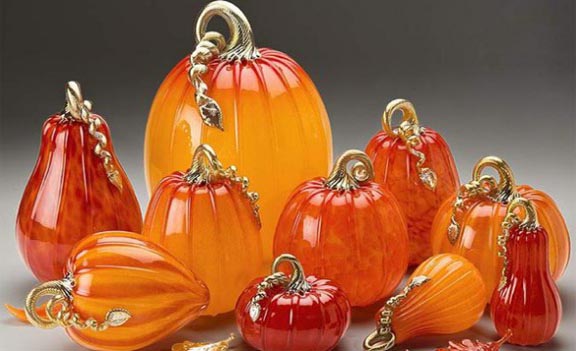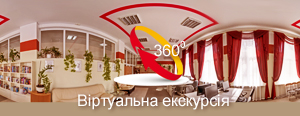Fig.1 https://sites.google.com/site/ukraienskiremeslatrad/remeslaukrain/biseropletenie
Glass articles produced manually or huta glass are applied in the household and for interior decoration.
Ukrainian “huta” originated from the German word “die Hutte” (“hearth”, “glassmaking furnace” and “the building with the furnace”). In many European countries, this word was wide-spread that is why the glass manufactured in hutte workshop acquired the name of huta glass.
Deeper into the history of glass-making, one can learn that the first glass articles found at the territory of Ukraine date back to the 1st century A. C., namely in Northern Pontic where numerous Greek and Rome colonies were located. In Scythian burial mounds, the archaeologists found the ornaments made from glass with the colourful inclusions of paints. Further, the article called “steklianytsia” is mentioned in epic “The Song of Igor’s Campaign”.
Toponym “Huta” in Ukraine is common, around 90 villages are called Huta, Nova Huta (New Huta), Stara Huta (Old Huta) or their names are derivatives from this word. They are mainly found in oblasts of Chernihivska, Lvivska, Ivano-Frankivska, Khmelnytska, Zakarpatska, Zhytomyrska. One can also encounter such names in Vinnychyna, Volyn (Volhynia), Kyivtschyna, Rivnentschyna and Symtschyna. To obtain glass, a lot of wood is required, that is why hutas were built in forest areas. This implies the name of “hutnyk” for the craftsman who produced glass and the articles from it.
Glassmaking is the magic in reality and one of the most original forms of decorative and applied arts. In huta production, the raw materials is one of the most important constituents (sand, soda ash and wood for igniting the process and further burning). But no less important one is the craftsmеn: the huta craftsman (hutnyk), the glass-maker and the glass-blower. To teach a skillful craftsman is a lengthy instruction, which in old times could take him from 5 to 10 years. In one huta, there worked from 10-15 workers and the equal number of the workforce was procuring sand and wood and delivering them.
Huta glass is obtained by fusing sand, limestone and potassium-bearing constituents at high temperatures in large clay pots (crucibles). The production techniques of free-blowing or casting into moulds are applied for the huta glass shaping into the articles, which is performed nearby the glass furnace. Every article is individual and unique, has its distinctive features of colour, transparency, luster, light beam refraction and light playing on its surface. Spreading, twisting, drawing and sculpting with metallic tools were the methods and techniques for shaping the fused mass into the glass articles at the early beginning of this craft. The artisans manually produced window glass, various glassware and decorations.
In Ukraine, glass manufacturing emerged at the turn of the 10th and 11th centuries, its development is related to the flourishing of Kievan Rus culture, one of the best developed states in Europe of that time. The first hutas were built in starostwy (regions) of Belzkyi, Horodetskyi and Lubachivskyi in the western lands of Ukraine.
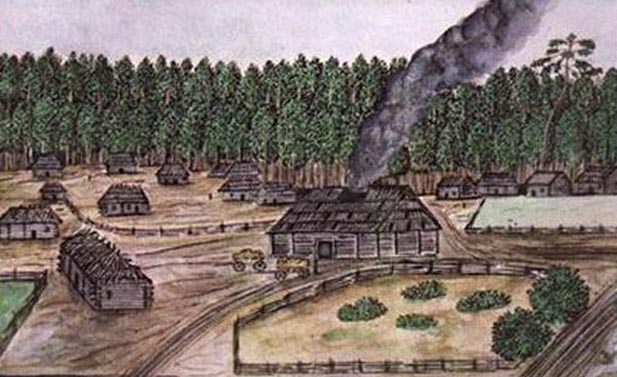
In the 12th century, hutas were established in Lwów starostwo, in the region of Zakarpattia (near Mukacheve) while the principal ones – in Volhynia and Kyivtschyna. The second half of 12th century saw the spread of hutas at the Livoberezhna Ukraina (Left-Bank Ukraine) and Slobozhanshchyna. Their greatest concentration was at Chernihivshchyna and totaled 120 hutas.
At the end of the 12th century at the Livoberezhna Ukraina, there were 25 hutas which were producing window glass, glassware (including that for medical needs), various bottle containers, crystal glass, optical glass, smalt for wall mosaics and floor of the churches and cathedrals. Smalt, by the way, which was applied for mosaics decoration in Saint Sophia Cathedral in Kyiv in the 11th century, was also manufactured in hutas of the Ukrainian land.
In the 16h -17th centuries, the glass workshops were manufacturing mainly two kinds of products: window glass and glassware: the sklianka (the drinking glass), the pliashka (bottle), the baklaha (the flat travelling bottle for water), the dzban (the pot-like bottle), the kelykh (the cup), the kukhlyk (the mug), the charka (the small glass for alcohol drinks). In the 18th century, the range of products was significantly wider. Not only the rich but also some of the Ukrainian villagers could afford the usage of large glass barrels and bowls for storing wheat, cereals, flour as well as plates for dishes and various glassware of intricate shapes for liquids: the hlek (the jug), the karafka (the carafe), the stof, the dzban, the dratyna (the ball-like bowl), the baryltse (the barrel).
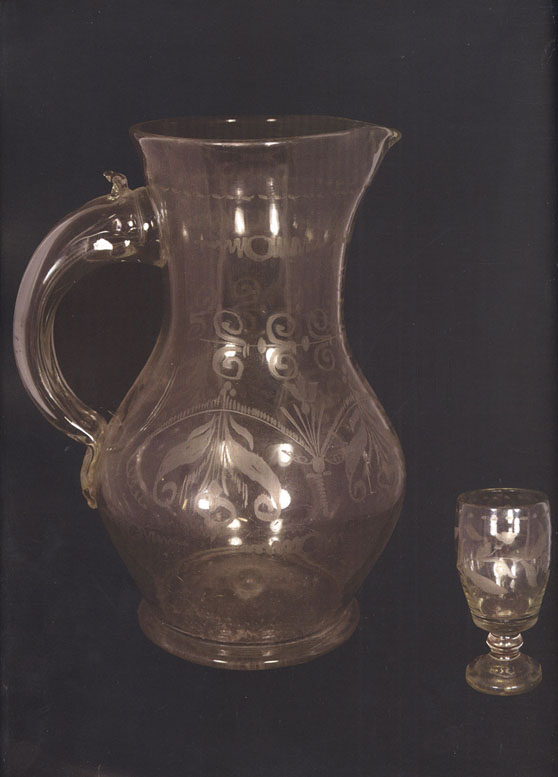
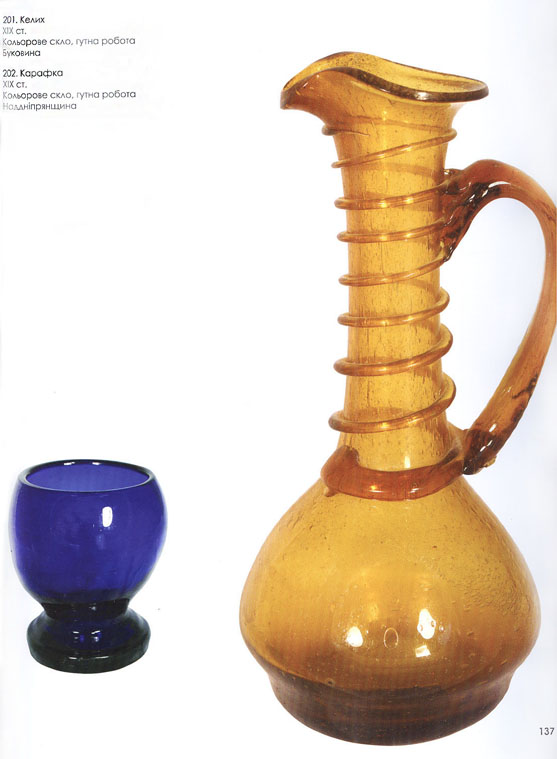
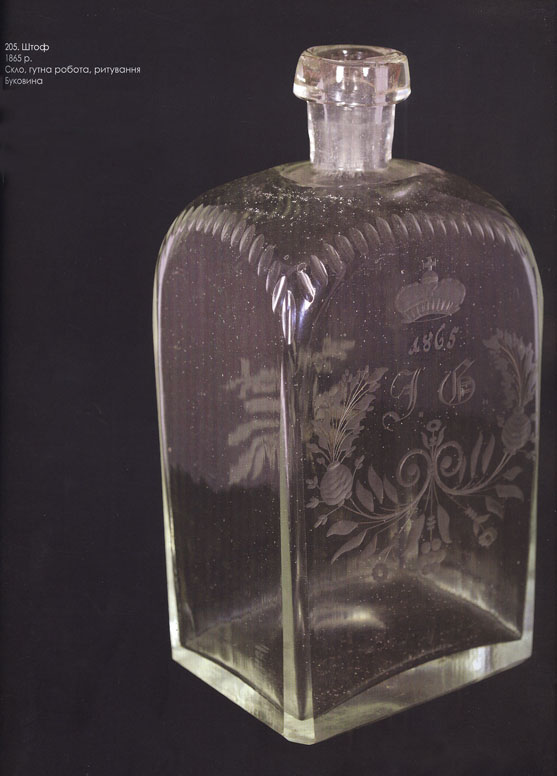
A great share of the Ukrainian glassware was given to the articles of the intricate shapes for storing liquids. This type of production is classified as a decorative means. It was rather popular. Ukrainian huta craftsmen could sculpture over it while the material, as they say, “is alive”, applying the technique of free-blowing. These articles acquired the images of animals and birds, mainly of green, brown and green-yellowish colours. The most popular became the containers which were shaped as bears or rams, which took the position of the obligatory item of the fest. The explanation for this is simple: the image of the bear is the symbol of the happiness in marriage while the ram means richness. The glassware was decorated according to the glass-making traditions which were as old as Rus: glass elements of plastic ropes, ribbons, silver and golden threads. The glassware could be painted in enamel or oil paints; were often applied the ornaments of Ukrainian wall paintings.
Glass figurines remind us of the puppet theatre, which is capable of starting the performance at any minute. That was the magical function of these figurines which was considered the principal one in old times. Only later it acquired the esthetic meaning.
The characteristic feature of the Ukrainian huta figurine tableware is in its original relevance to the samples of every-day tableware. Thus, the shapes of the birds were inspired by the round

bottle. The bear shape and the horse shape were taken from the cylindrical bottle while those of the ram and the boar were the redesigned shapes of a barylo (a barrel).
The period of the greatest prosperity for huta art in Ukraine was in the 18th century and the first half of the 19th century, that was the time when crystal glassware was also produced there. The rich pomitschyk (a landlord) or the schliakhta (noble people) could order such expensive crystal glassware with engravings and carvings of portraits, monograms and coats of arms. The articles from glass were often decorated with exquisite flower and plant ornaments or plant and geometric ornaments. To serve their fests, people employed stofs, dzbans, karafkas, cups and glasses, commonly produced from colorless glass, less often from colourful one. Sculpture sklianytsia (glassware) was used for special events of weddings, baptising or religious holidays. Glassware decorated with paintings was closely related to the folk traditions of art: these are the items of sculpture glassware, dzbans, stofs, cylindrical mugs for beer and honey. The huta craftsman produced the articles of joking mood. For instance, they placed a glass bear or a bird inside the article. For storing bulk products and liquids, large glassware was manufactured: the myska (bowl), the butl (pumpkin-like bottle), the mydnytsia (large bowl), the sulia (large bottle). The baklaha and the flask of flat shape belonged to the travelling glassware. The baryltsia of various sizes were produced and decorated with glass threads, even or corrugated hoops.
Rather popular products were the laced vase, the ink-pot, the sugar-pot, the candle stick, the halo (the device for straitening namitka (women’s head-dress), even the glass mortar with the stamper, the rolling-pin for pastry spreading, the pot for plants.
In the middle of 19th century, huta production decayed in Ukraine. For glass-blowers and craftsman, it was hard to compete with huge glass factories, which equipment was much better. Also, they ran short of the workforce when serfdom was abolished.
However, Ukraine gradually renewed its glass blowing art and it continues to catch the admired glances and surprise with its original and unexpected products.
Svitlana Hamzina
(this publication relies on the information from the DOUNB book collection and e-sources)
Our Advice to Read:
Рожанківський В.Ф. Українське художнє скло.– Київ: Вид-во АН УРСР, 1959.– 151 с.: 1 мапа.
Українське народне мистецтво: альбом-каталог / упоряд. О. Лозинський.– Львів: Коло, 2021. - 432 с.: фот.
Ящинин Й.М. Технологія скла: у 3-ох ч. Ч. 1: Фізика і хімія скла: підручник.– Львів: Вид. Нац. ун-ту «Львівська політехніка», 2001.– 188 с.


